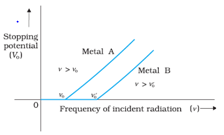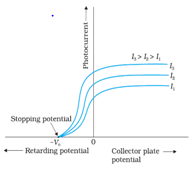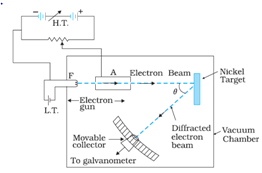CBSE Class 12 Physics Chapter 11 Dual Nature of Radiation and Matter Notes in PDF are available for free download in myCBSEguide mobile app. The best app for CBSE students now provides Dual Nature of Radiation and Matter class 12 Notes latest chapter wise notes for quick preparation of CBSE board exams and school-based annual examinations. Class 12 Physics notes on chapter 11 Dual Nature of Radiation and Matter are also available for download in CBSE Guide website.
CBSE Guide Dual Nature of Radiation and Matter Class 12 Notes Physics
CBSE guide notes are the comprehensive notes which covers the latest syllabus of CBSE and NCERT. It includes all the topics given in NCERT class 12 Physics textbook. Users can download CBSE guide quick revision notes from myCBSEguide mobile app and my CBSE guide website.
Class 12 Physics notes Chapter 11 Dual Nature of Radiation and Matter
Download CBSE class 12th revision notes for chapter 11 Dual Nature of Radiation and Matter in PDF format for free. Download revision notes for Dual Nature of Radiation and Matter class 12 Notes and score high in exams. These are the Dual Nature of Radiation and Matter class 12 Notes prepared by team of expert teachers. The revision notes help you revise the whole chapter 11 in minutes. Revision notes in exam days is one of the best tips recommended by teachers during exam days.
Download Revision Notes as PDF
CBSE Class 12 Physics Revision Notes Chapter-11 Dual Nature of Radiation and Matter
- Electric Discharge: The passage of an electric current through a gas is called electric discharge.
- Discharge Tube: A hard glass tube along with the necessary arrangement, which is used to study the passage of electric discharge through gases at low pressure, is called a discharge tube.
- Cathode Rays: Cathode rays are the stream of negatively charged particles, electrons which are shot out at a high speed from the cathode of a discharge tube at pressure below 0.01 mm of Hg.
- Work Function: The minimum amount of energy required by an electron to just escape from the metal surface is known as work function of the metal.
- Electron Emission: The minimum amount of energy required by an electron to just escape from the metal surface is known as work function of the metal.
- Thermionic Emission: Here electrons are emitted from the metal surface with the help of thermal energy.
- Field or Cold Cathode Emission: Electrons are emitted from a metal surface by subjecting it to a very high electric field.
- Photoelectric Emission: Electrons emitted from a metal surface with the help of suitable electromagnetic radiations.
- Secondary Emission: Electrons are ejected from a metal surface by striking over its fast-moving electrons.
- Forces Experienced by an Electron in Electric and Magnetic Fields:-
- Electric field: The force FE experienced by an electron e in an electric field of strength (intensity) E is given by, FE = eE
- Magnetic field: The force experienced by an electron e in a magnetic field of strength B weber/m2 is given by,FB=Bev
where v is the velocity with which the electron moves in the electric field and the magnetic field, perpendicular to the direction of motion. - If the magnetic field is parallel to the direction of motion of electron, then, FB = 0.
- Photoelectric Effect: The phenomenon of emission of electrons from the surface of substances (mainly metals), when exposed to electromagnetic radiations of suitable frequency, is called photoelectric effect and the emitted electrons are called photoelectrons.
- Maximum K. E of the Photoelectrons Emitted from the Metal Surface:
(Einstein’s Photoelectric equation) - Cut Off or Stopping Potential: The value of the retarding potential at which the photoelectric current becomes zero is called cut off or stopping potential for the given frequency of the incident radiation.

- Threshold Frequency: The minimum value of the frequency of incident radiation below which the photoelectric emission stops altogether is called threshold frequency.
- Laws of Photoelectric Effect:
- For a given metal and a radiation of fixed frequency, the number of photoelectrons emitted is proportional to the intensity of incident radiation.
- For every metal, there is a certain minimum frequency below which no photoelectrons are emitted, howsoever high is the intensity of incident radiation. This frequency is called threshold frequency.
- For the radiation of frequency higher than the threshold frequency, the maximum kinetic energy of the photoelectrons is directly proportional to the frequency of incident radiation and is independent of the intensity of incident radiation.
- The photoelectric emission is an instantaneous process.


- Einstein’s Theory of Photoelectric Effect:-
- Einstein explained photoelectric effect with the help of Planck’s quantum theory.
- When a radiation of frequency is incident on a metal surface, it is absorbed in the form of discrete packets of energy called quanta or photons.
- A part of energy of the photon is used in removing the electrons from the metal surface and remaining energy is used in giving kinetic energy to the photoelectron.
- Einstein’s photoelectric equation is,
Where wo is the work function of the metal. - If is the threshold frequency, then
- All the experimental observations can be explained on the basis of Einstein’s photoelectric equation.
- Compton Shift: It is the phenomenon of increase in the wavelength of X-ray photons which occurs when these radiations are scattered on striking an electron. The difference in the wavelength of scattered and incident photons is called Compton shift, which is given by
Where is the angle of scattering of the X-ray photon and m0 is the rest mass of the electron. - Charge and Mass of an Electron by Thomson’s Method:
- J. J. Thomson devised an experiment to determine the velocity (v) and the ratio of the charge (e) to the mass (m) i.e., of cathode rays.
- In this method, electric field and magnetic field are applied on the cathode rays.
- In the region where they are applied perpendicular to each other and to the direction of motion of cathode rays,
Force due to electric field, FE = Force due to magnetic field FB,
Also,
Where V = Potential difference between the two electrodes (i.e., P and Q), d = distance between the two electrodes, R = radius of circular arc in the presence of magnetic field B, x = shift of the electron beam on the screen,
l = length of the field and L = distance between the centre of the field and the screen.
- Milliken’s Oil Drop Method:
- This method helps to determine the charge on the electron.
- Let be the density of oil, is the density of the medium in which oil drop moves and the coefficient of viscosity of the medium, then the radius r of the drop is Where v0 is the terminal velocity of the drop under the effect of gravity alone.
- At the terminal velocity v0, the force due to viscosity becomes equal to the weight of the body.
- The charge on oil drop is
Where v1 is the terminal velocity of the drop under the influence of electric field and gravity and E is the applied electric field.
- Photocell:
- It is an arrangement which converts light energy into electric energy.
- It works on the principle of photoelectric effect.
- It is used in cinematography for the reproduction of sound.
- Dual Nature of Radiation: Light has dual nature. It manifests itself as a wave in diffraction, interference, polarization, etc., while it shows particle nature in photoelectric effect, Compton scattering, etc.
- Dual Nature of Matter:
- As there is complete equivalence between matter (mass) and radiation (energy) and the principle of symmetry is always obeyed, de Broglie suggested that moving particles like protons, neutrons, electrons, etc., should be associated with waves known as de Broglie waves and their wavelength is called de Broglie wavelength.
- The de Broglie wavelength of a particle of mass m moving with velocity v is given by-
Where h is Planck’s constant.
- Davison and Germer Experiment: This experiment help to confirm the existence of de Broglie waves associated with electrons.
- De Broglie Wavelength of an Electron: The wavelength associated with an electron beam accelerated through a potential.
- de Broglie wavelength associated with the particle of momentum p is-
Where V is the magnitude of accelerating potential. - Heisenberg Uncertainty Principle: Where is uncertainty in position & is uncertainty in momentum
- Electron Microscope:
- It is a device which makes use of accelerated electron beams to study very minute objects like viruses, microbes and the crystal structure of solids.
- It has a magnification of .
- Davisson-Germer Electron Diffraction Arrangement:


CBSE Class 12 Revision Notes and Key Points
Dual Nature of Radiation and Matter class 12 Notes. CBSE quick revision note for class-12 Physics, Chemistry, Math’s, Biology and other subject are very helpful to revise the whole syllabus during exam days. The revision notes covers all important formulas and concepts given in the chapter. Even if you wish to have an overview of a chapter, quick revision notes are here to do if for you. These notes will certainly save your time during stressful exam days.
- Physics
- Chemistry
- Mathematics
- Biology
- Accountancy
- Economics
- Business Studies
- Computer Science
- Informatics Practices
- English Core
- History
- Physical Education
To download Dual Nature of Radiation and Matter class 12 Notes, sample paper for class 12 Physics, Chemistry, Biology, History, Political Science, Economics, Geography, Computer Science, Home Science, Accountancy, Business Studies and Home Science; do check myCBSEguide app or website. myCBSEguide provides sample papers with solution, test papers for chapter-wise practice, NCERT solutions, NCERT Exemplar solutions, quick revision notes for ready reference, CBSE guess papers and CBSE important question papers. Sample Paper all are made available through the best app for CBSE students and myCBSEguide website.
- Electric Charges and Fields class 12 Notes Physics
- Electrostatic Potential and Capacitance class 12 Notes Physics
- Current Electricity class 12 Notes Physics
- Moving Charges and Magnetism class 12 Notes Physics
- Magnetism and Matter class 12 Notes Physics
- Electromagnetic Induction class 12 Notes Physics
- Alternating Current class 12 Notes Physics
- Electromagnetic Waves class 12 Notes Physics
- Ray Optics and Optical class 12 Notes Physics
- Wave Optics class 12 Notes Physics
- Atoms class 12 Notes Physics
- Nuclei class 12 Notes Physics
- Electronic Devices class 12 Notes Physics
- Communication Systems class 12 Notes Physics

Test Generator
Create question paper PDF and online tests with your own name & logo in minutes.
Create Now
Learn8 App
Practice unlimited questions for Entrance tests & government job exams at ₹99 only
Install Now